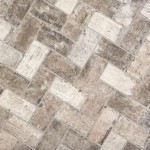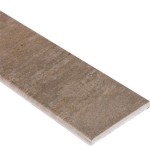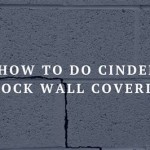How to Remove Vinyl Floor Tiles From a Concrete Slab
Removing vinyl floor tiles from a concrete slab can be a challenging task, often requiring patience and the proper tools. Vinyl tiles are typically adhered to the concrete using strong adhesives, making their removal labor-intensive. However, with the right techniques and preparation, the process can be managed effectively and the concrete slab prepared for a new flooring installation.
The success of vinyl tile removal hinges on understanding the type of adhesive used and the condition of both the vinyl and the concrete. Older tiles may contain asbestos, so testing is crucial before proceeding with any removal work. If asbestos is present, professional abatement is required. Assuming the tiles are asbestos-free, several methods can be employed to soften the adhesive and lift the tiles, ranging from heat application to chemical solvents.
Proper preparation is paramount for ensuring a safe and efficient removal process. This involves assessing the work area, gathering necessary tools and safety equipment, and understanding potential hazards. Neglecting these steps can lead to delays, injuries, and damage to the concrete slab.
Key Point 1: Preparation and Safety Precautions
Before commencing any removal work, a thorough assessment of the area is necessary. This includes inspecting the existing vinyl tiles and the concrete slab for any signs of damage, such as cracks or unevenness. Identifying these issues beforehand will allow for appropriate adjustments to the removal strategy and prevent further complications.
Safety is a primary concern. Vinyl tile removal can generate dust and potentially release volatile organic compounds (VOCs) from the adhesive. Therefore, adequate ventilation is essential. Opening windows and doors to allow for airflow is crucial. If natural ventilation is insufficient, consider using a fan to circulate air and exhaust it outdoors. Wearing appropriate personal protective equipment (PPE) is also mandatory.
Required PPE includes: a respirator mask rated for dust and organic vapors, safety glasses or goggles to protect the eyes from debris, and work gloves to protect the hands from sharp edges and chemical irritants. Long sleeves and pants are recommended to minimize skin exposure. In some cases, particularly when aggressive solvents are used, a chemical-resistant suit may be necessary.
The necessary tools for vinyl tile removal can vary depending on the chosen method, but a basic toolkit should include: a floor scraper with a replaceable blade, a heat gun or hair dryer (for heat application), a utility knife, a pry bar or chisel, a hammer, a putty knife, and a heavy-duty garbage bag for waste disposal. Additional tools might include a solvent applicator (such as a brush or sprayer) and a concrete grinder or scraper for removing stubborn adhesive residue.
Protecting surrounding areas is also an important aspect of preparation. Cover nearby walls and furniture with plastic sheeting to prevent dust and debris from spreading. Secure the sheeting with painter's tape. If possible, remove any furniture or valuables from the room before starting the removal process.
Key Point 2: Methods for Removing Vinyl Tiles
Several methods can be used to remove vinyl floor tiles from a concrete slab, each with its own advantages and disadvantages. The best approach will depend on the type of adhesive used, the size of the area being worked on, and the available tools and resources.
Heat Application: This method involves using heat to soften the adhesive, making it easier to lift the tiles. A heat gun or hair dryer can be used to apply heat directly to the vinyl tiles, starting at one corner. The heat should be applied evenly and cautiously, ensuring that the vinyl does not overheat or melt. Once the adhesive is softened, a floor scraper or putty knife can be used to pry up the tile. This method is generally effective for smaller areas and for tiles that are not heavily adhered.
Solvent Application: Chemical solvents can dissolve or weaken the adhesive bond, making it easier to remove the tiles. Various solvents are available, including adhesive removers specifically designed for vinyl flooring. It is crucial to choose a solvent that is compatible with both the vinyl and the concrete and to follow the manufacturer's instructions carefully. When using solvents, adequate ventilation is essential, and appropriate PPE, including a respirator mask and gloves, should be worn. Apply the solvent to the tiles, allowing it to dwell for the recommended time before attempting to scrape or lift the tiles. This method can be effective for larger areas but requires careful handling and disposal of the solvent.
Scraping and Prying: This is a more manual method that involves using a floor scraper, pry bar, or chisel to physically remove the tiles. Start by scoring the edges of the tile with a utility knife to create a clean separation. Then, insert the scraper or pry bar under the tile and apply leverage to lift it from the concrete. A hammer may be needed to tap the scraper or chisel to help break the adhesive bond. This method can be labor-intensive, especially for large areas or tiles that are strongly adhered, but it is often necessary in conjunction with other methods.
Steam Removal: A steam cleaner can be used to apply heat and moisture to the tiles, softening the adhesive. Direct the steam nozzle onto the tile for a few seconds, then try to lift the tile with a scraper or putty knife. The steam helps to loosen the adhesive without the use of harsh chemicals. This method is generally considered safer and more environmentally friendly than solvent application, but it may not be as effective for heavily adhered tiles.
Combining methods can often yield the best results. For example, applying heat to a tile before scraping it, or using a solvent to soften the adhesive before prying it up. Experimenting with different techniques and finding what works best for the specific type of adhesive and tile is often necessary.
Key Point 3: Removing Adhesive Residue and Preparing the Concrete Slab
After the vinyl tiles have been removed, adhesive residue will likely remain on the concrete slab. Removing this residue is crucial for creating a smooth, clean surface for the new flooring installation. Several methods can be used to remove adhesive residue, depending on the type and thickness of the residue.
Solvent Application: The same solvents used for tile removal can often be effective for removing adhesive residue. Apply the solvent to the residue, allowing it to dwell for the recommended time, and then scrape it away with a putty knife or floor scraper. Multiple applications may be necessary for stubborn residue. Ensure adequate ventilation and wear appropriate PPE when using solvents.
Mechanical Removal: A concrete grinder or scraper can be used to mechanically remove adhesive residue. A concrete grinder uses abrasive discs to grind away the residue, creating a smooth surface. A floor scraper with a sharp blade can also be used to scrape away the residue. This method can be effective for removing thick or hardened residue but can also generate a significant amount of dust. Wear a respirator mask and eye protection when using mechanical removal methods. A vacuum cleaner with a HEPA filter can be used to collect the dust as it is generated.
Scraping and Sanding: For smaller areas or lighter residue, a putty knife or scraper can be used to manually scrape away the adhesive. Sandpaper (coarse grit) can then be used to smooth out any remaining residue. This method is less aggressive than using a concrete grinder but can be effective for removing thin layers of adhesive.
Once the adhesive residue has been removed, thoroughly clean the concrete slab. Sweep or vacuum up any remaining debris. Wash the slab with a mild detergent and water to remove any residual solvent or cleaning agent. Allow the slab to dry completely before proceeding with the new flooring installation.
Inspect the concrete slab for any damage, such as cracks or unevenness. Repair any cracks with a concrete patching compound. Level any uneven areas with a self-leveling compound. Allow the patching compound and self-leveling compound to dry and cure according to the manufacturer's instructions.
Finally, ensure that the concrete slab is properly prepared for the new flooring installation. This may involve applying a primer or sealant to the slab to improve adhesion and prevent moisture transmission. Follow the manufacturer's instructions for the primer or sealant being used.
Properly preparing the concrete slab is essential for ensuring a successful and long-lasting flooring installation. Taking the time to remove adhesive residue and repair any damage will result in a smoother, more durable surface that will enhance the performance and appearance of the new flooring.

How To Remove Floor Tiles From Concrete Our Guide

Removing Tile On Concrete Slab Easy

The Fastest Way To Remove Bonded Vinyl Flooring From Concrete

Removing Tile From A Concrete Slab

The Best Way To Remove Thinset From A Cement Foundation House Of Hepworths

How To Remove Vinyl Flooring The Home Depot

How To Finish Removing Linoleum Adhesive For Tile On Concrete Floor Hometalk

Carpet Tile Removal Slab Prep Lifeproof Vinyl Plank Flooring Front Room Renovation Ep 1

How To Remove Vinyl Flooring The Home Depot

How To Remove Floor Tiles From Concrete Superior
Related Posts








